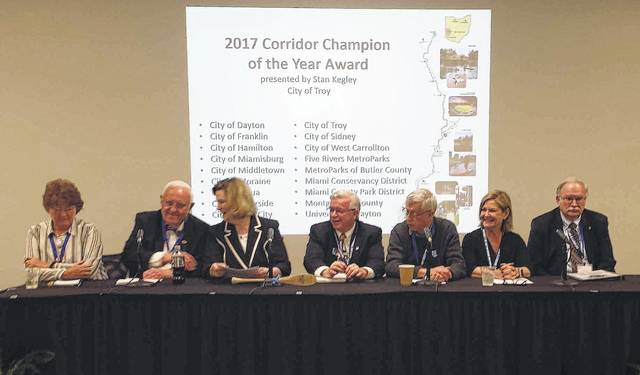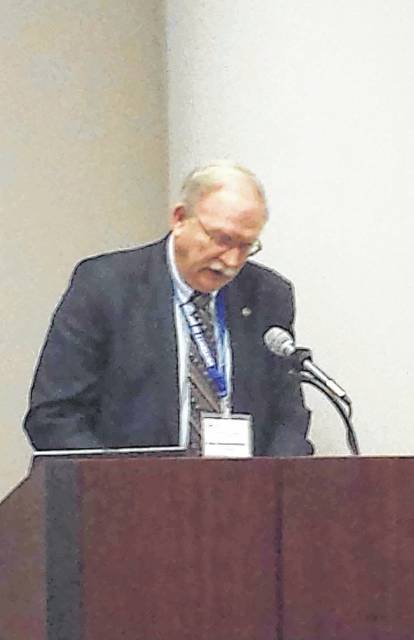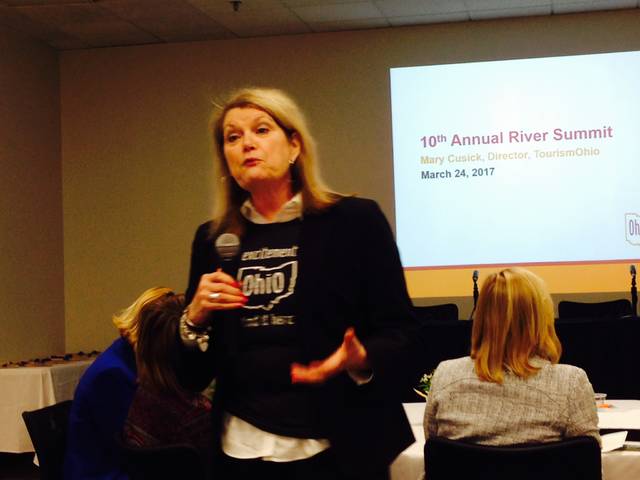



DAYTON — Sidney Mayor Mike Barhorst, 4th Ward City Councilman Steve Wagner and City Manager Mark Cundiff joined more than 200 other regional officials Friday for the 10th Annual River Summit. This year’s event, “The Future of Our Corridor: the Great Miami Riverway,” was had at the University of Dayton’s River Campus.
Miami Conservancy District’s (MCD) Sarah Hippensteel provided those in attendance with an update of the MCD’s place-making and wayfinding initiative.
”Our story began 104 years ago this week when a few into simple rain drops turned into one of the greatest natural disasters of our time,” Hippensteel said. “A massive storm system dumped between 9-11 inches of rain over the entire region. This storm killed hundreds, left thousands homeless, and cost more than $2 billion. Our communities decided once and for all to protect themselves with a permanent solution to the threat of flooding, and the Miami Conservancy District was born.”
“During the 20th century riverfront cities were focused on protecting themselves from the river,” Hippensteel continued. “In the 21st century we are focused on attracting people to the river. Attracting visitors. Attracting businesses. And attracting and retaining a talented workforce. This region is a short-term home to more than 200,000 college students – and we want them to stay forever.”
“The good news is we have what it takes. 330 miles of paved trails; the only national designated water trail in Ohio, which by the way, is also a state designed water trail; more than 100 parks of all shapes and sizes, a palette for everyone from mom and pop diners to international cuisine, plus enough shops to max out your credit card. And the well-managed farmland and preserved open spaces that rank the Great Miami Rivers and its tributaries among the best quality waterways in the state,” Hippensteel said.
”If you remember, the strongest recommendation from the US Army Corps of Engineers Great Miami River Study was that we develop a strong, unified identity for the river corridor and capitalize on each community’s character,” Hippensteel said. “The Army Corps said and I quote ‘The more a river corridor is known by a well-articulated and unifying identity, the more investment of both private and public funds is directed at projects that produce quality-of-life gains as well as economic returns and improved conservancy of important lands and water.’
“All of us took the US Army Corps of Engineers’ recommendation very seriously. For months, many of us in this room have worked together to create a new identity, a new brand for the river corridor,” Hippensteel said as she unveiled the new logo.
Hippensteel noted the Great Miami Riverway is more than just the river.
“It’s the unique river towns, abundant land and water recreation opportunities, fun activities and programs, popular events and festivals, and world-class arts, cultural and historic destinations,” Hippensteel said. “This brand is now the foundation for a five-year plan to market and promote the Great Miami Riverway. This placemaking initiative, facilitated by MCD at the request of a partnership of riverfront communities and organizations, will be used to promote the region as a destination and to: 1) increase use of our recreational, historical and cultural assets; 2) attract more visitors; 3) support economic development; and, 4) strengthen our river corridor neighborhoods.”
Hippensteel thanked the Great Miami Riverway partners, including Montgomery County, the Miami Conservancy District, the Cities of Sidney, Piqua, Troy, Dayton, Miamisburg, West Carrollton, Franklin, and Hamilton along with the Miami County Park District, Five Rivers MetroParks, and MetroParks of Butler County.
Studio Graphique’s Garoline Chaikin and Cathy Fromet discussed the importance of branding. They then reviewed the process they had used in helping to design the new log for the Great Miami Riverway.
Mary Cusick, director of TourismOhio was joined by Melinda Huntley, Executive Director of the Ohio Travel Association in discussing the important role that tourism plays in Ohio’s economy. “In 2015, more than 207 million people visited the State of Ohio,” Cusick told her audience. “Each visitor who spent the day spent on average $110 per person. For those who spent the night, the amount per person balloons to $354. The more there is for visitors to do, the longer they will stay.”
“There has been a 27 percent increase in direct visitor spending since 2011. We also know that 73 percent of those who travel are more focused on experiences than on purchasing material items,” Cusick continued. “The Great Miami Riverway is well-suited to take advantage of the opportunities that are increasingly available along the river corridor.”
A panel of representatives from cities who are participating with the Great Miami Riverway spoke about how their communities are currently utilizing the river. In addition to Barhorst, the panel included Piqua Mayor Kazy Hinds, Troy Mayor Michael Beamish, Dayton Mayor Nan Whaley, Riverside Mayor Bill Flaute, Miamisburg Mayor Dick Church, and Hamilton Vice-Mayor Carla Fiehrer.
“Historically, the river has been seen as a tremendous asset for just two reasons: every day, we draw 3 to 5 million gallons of water from the river to be processed as drinking water; and, every day, on the other side of our great municipality, we return 5 to 8 million gallons of processed water to the river from the wastewater treatment plant,” Barhorst said in his prepared remarks.
”Otherwise, the Great Miami River was seen as a barrier across which bridges had to be constructed to get to the other side,” Barhorst said. “Following the Great Flood of 1913, local leaders saw no reason to treat the river as anything more than an eccentric relative you hope doesn’t visit too often or stay too long.
“It has only been in recent years that residents have begun to ask questions like: why doesn’t our river bank look more like those in Piqua and Troy; why don’t we have a bicycle path along the river; why don’t we have a canoe livery; wouldn’t it be nice if there were a bicycle shop that would rent bicycles that was located along the river?” Barhorst said.
“Section by section, the city has worked to develop the Canal Feeder Trail, which thus far follows the Great Miami River. As each section is completed, we get a bit closer to a trail that will eventually connect the city of Sidney with the city of Piqua’s trail system, and the compass points of their system.” Barhorst stated. “In addition, within the past three months, I have spoken to three developers who expressed their interest in wanting to be near the river for their respective projects – so it may be that as Sidney may eventually come to see the river more as a rock star who has come to live in the community and who on a daily basis, offers free concerts for residents and visitors alike.”
Other sessions included “Innovative Recreation Projects,” “Highlights of the University of Dayton River Steward Program” and “How Safe is it,” a session on the bacterial contamination of the river and the impact on those who use the river for recreation.





